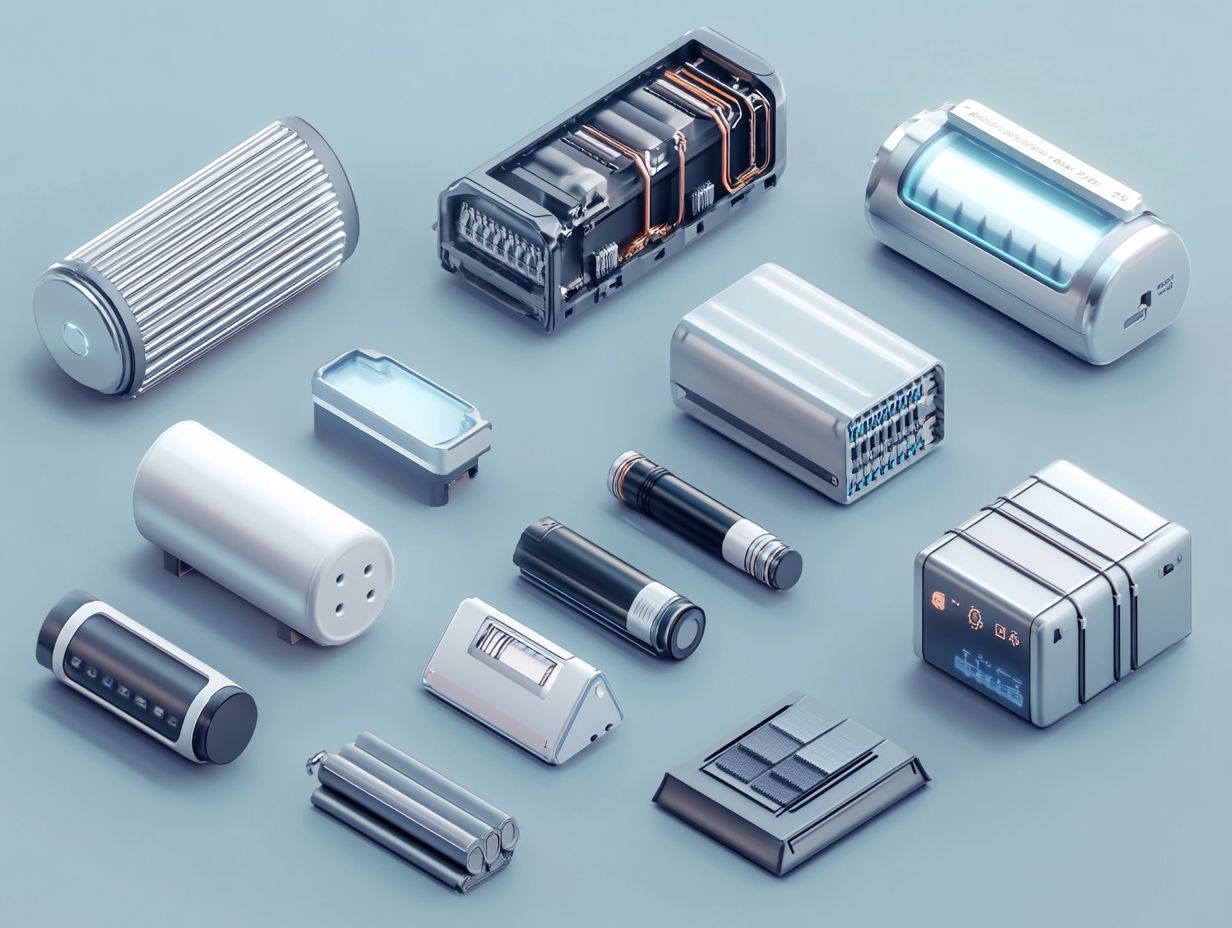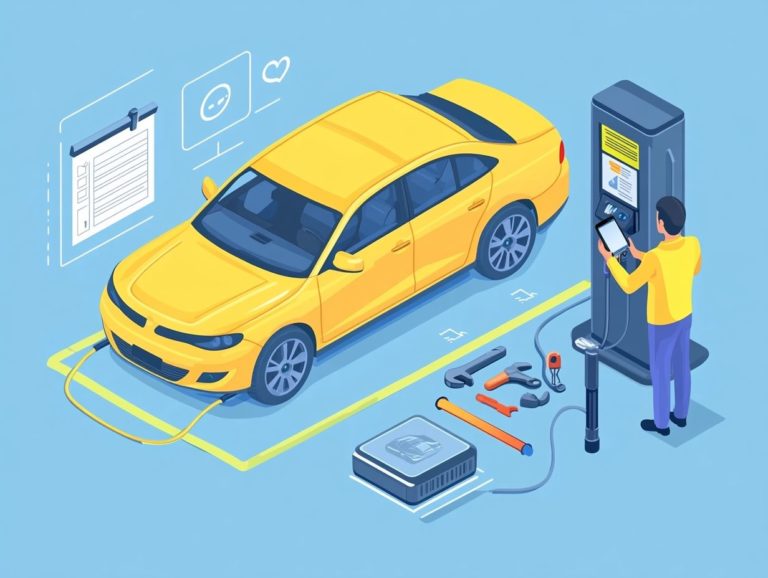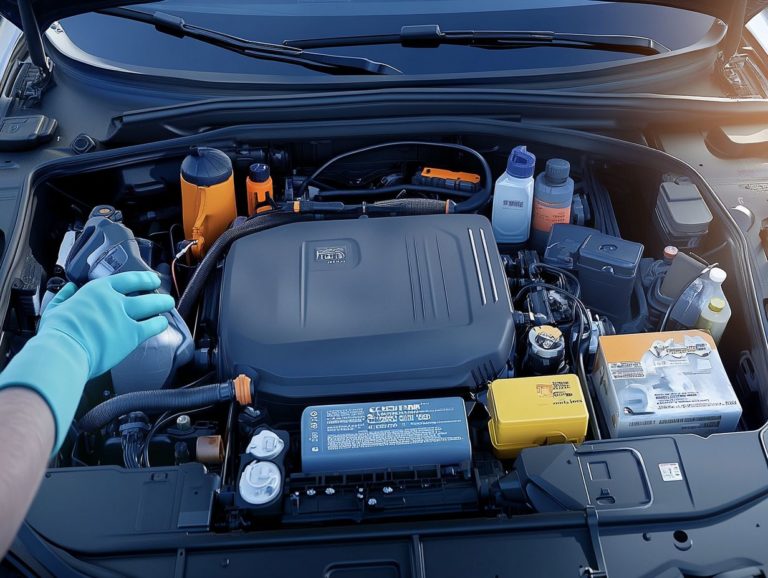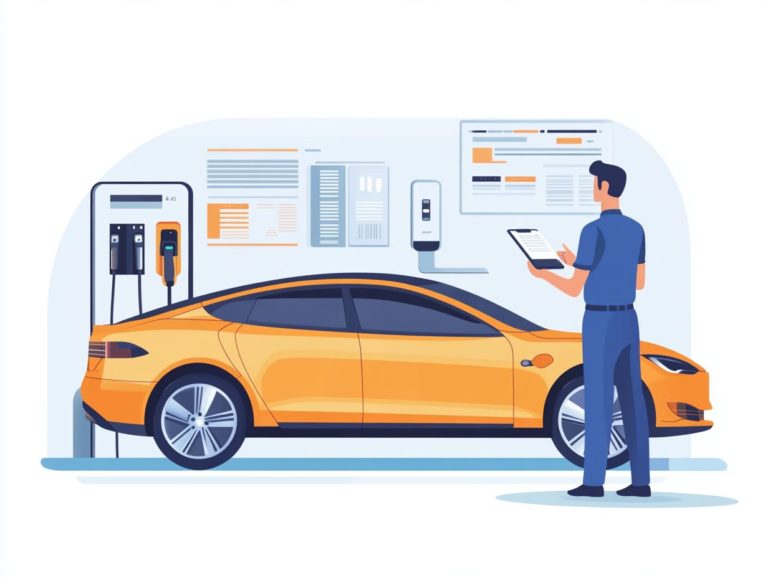Understanding Different EV Battery Types
As electric vehicles (EVs) continue to gain momentum in the automotive landscape, it s essential for you to understand their power source batteries.
In this article, we explore various types of EV batteries, including lithium-ion, nickel-metal hydride, and solid-state options. Each type presents unique benefits and drawbacks.
You ll find a comparison of their efficiency, costs, and maintenance requirements. This will make it easier for you to navigate the complexities of selecting the ideal battery for your needs.
We will also explore emerging trends that could shape the future of EV technology. This knowledge will keep you informed and ahead of the curve.
Contents
- Key Takeaways:
- Types of EV Batteries
- Comparison of EV Battery Types
- Choosing the Right EV Battery
- Frequently Asked Questions
- What are the different types of EV batteries?
- What is the difference between lead-acid and nickel-metal hydride batteries?
- How does a lithium-ion battery differ from other EV batteries?
- Which type of EV battery is best for long-distance driving?
- What are the benefits of using different types of EV batteries?
- Can EV batteries be recycled?
Key Takeaways:

- Lithium-ion batteries are the most common choice for EVs due to their high energy density and long lifespan.
- Nickel-metal hydride and lithium polymer batteries have advantages but are less common due to lower energy density and higher costs.
- When choosing an EV battery, consider cost, performance, and the potential of solid-state batteries for greater efficiency.
What are EV Batteries?
Electric Vehicle (EV) batteries are crucial to how electric vehicles operate. They enable vehicles to run efficiently and sustainably.
These batteries store and deliver electrical energy, ensuring top performance while minimizing environmental impact.
Various types of EV batteries, like lithium-ion, NMC (Nickel Manganese Cobalt), and LFP (Lithium Iron Phosphate), enhance energy density and charging performance.
With advancements in technology, concerns like safety and lifecycle management are being effectively addressed, improving reliability.
NMC batteries are known for high energy density and stable heat management. LFP batteries excel in safety and longevity, making them great for fleet vehicles.
Both battery types help advance car energy efficiency. By focusing on battery improvements, we can reduce the carbon footprint linked to vehicle production and use.
Types of EV Batteries
The world of EV batteries is diverse, featuring various types, each with unique features and uses. Key players include lithium-ion, NMC, and LFP batteries.
Alternative technologies like solid-state and sodium-ion batteries are also emerging, aimed at transforming energy storage solutions.
Lithium-ion Batteries
Lithium-ion batteries are the go-to choice for electric vehicles. They are celebrated for their remarkable energy density and efficiency.
Major car manufacturers like Tesla, BYD, and Audi widely use these batteries due to their excellent performance in charging cycles and heat stability.
These batteries can store a significant amount of energy relative to their size. This makes them ideal for electric vehicles, where space and weight matter.
Manufacturers appreciate their consistent power output and stable temperature maintenance. This ensures safer operations and extends the battery’s lifespan.
As the automotive industry shifts toward sustainable solutions, lithium-ion technology leads the way, improving the driving experience and promoting electric vehicle adoption!
Nickel-metal Hydride Batteries
Nickel-metal hydride (NiMH) batteries are a cornerstone in the automotive sector. They are prized for their durability and reliability in energy storage applications.
Automakers like Volvo and BMW have chosen them for certain models, particularly hybrids, because of their excellent charging performance and resistance to overheating issues. This means they are less likely to overheat.
One of the standout features of these batteries is their cost-effectiveness and impressive longevity. This makes them a dependable choice for hybrids that demand steady and consistent power output. However, when you stack them up against lithium-ion batteries, you’ll notice that NiMH batteries typically have lower energy density. This means they tend to occupy more space and weigh more, which can compromise overall vehicle efficiency.
Their ability to support regenerative braking systems benefits hybrid vehicles. The rising demand for electric vehicles is shifting preferences toward lighter, more power-efficient lithium-ion technologies.
Understanding the role of these batteries is essential. It influences consumer choices and sets industry standards.
Lithium Polymer Batteries

Lithium Polymer batteries are increasingly capturing attention in the EV market, thanks to their lightweight design and versatile form factor. This makes them ideal for a variety of automotive applications.
With the latest advancements in energy density, these batteries offer a compelling solution for manufacturers seeking to elevate vehicle performance. Energy density refers to how much power a battery can hold relative to its size.
Their unique design allows for an array of shapes and sizes, making it easy to integrate them into vehicle designs and optimize the use of available space. When you compare them to traditional lithium-ion batteries, Lithium Polymer options stand out with a higher energy density. This allows them to store more energy while remaining lighter an essential quality for enhancing overall efficiency and range.
This advantage is especially significant in high-performance applications like electric vehicles and drones, where every metric counts. The automotive industry is buzzing with potential as these batteries might power the next generation of electric vehicles!
As the automotive industry continues to evolve, the potential for these batteries to improve both range and charging times is downright thrilling.
Lead-acid Batteries
Lead-acid batteries, while rooted in older technology, continue to be a go-to choice for various applications. They are cost-effective and offer reliable energy storage capabilities.
Though they may not be the star players in high-performance electric vehicles, they still play a crucial backup role in certain automotive models. In traditional vehicles, these batteries are particularly valuable, powering the starter and supporting the electrical systems.
Their lower upfront costs make them highly appealing to both budget-conscious consumers and manufacturers. When you stack lead-acid batteries against newer technologies like lithium-ion, the limitations become clear lower energy density and a reduced lifespan are just the beginning.
However, in non-EV contexts, lead-acid batteries remain essential for applications such as uninterruptible power supply (UPS) systems, solar energy storage, and recreational vehicles.
It s crucial to consider the environmental impact! Proper disposal and recycling are essential to avoid hazardous waste, highlighting the need for careful management and responsible practices.
Exciting New Solid-state Batteries
Get ready for solid-state batteries, the exciting new alternative that s set to change the game! These innovative batteries offer enhanced thermal stability and energy efficiency. By utilizing solid electrolytes materials that allow ions to move through while remaining solid these batteries have the potential to revolutionize the EV industry with safer and more efficient energy storage solutions.
Unlike conventional batteries that depend on liquid electrolytes which can lead to leaks and fires solid-state batteries significantly reduce these safety risks. This advanced technology boasts a higher energy density, allowing for longer driving ranges in electric vehicles.
Automotive manufacturers are intensely researching and developing these batteries to address challenges like cost and scalability. As key players refine their manufacturing processes, the likelihood of widespread adoption increases.
Improved thermal stability enhances safety and extends battery life, making solid-state batteries a compelling choice in the pursuit of more sustainable and efficient energy solutions.
Comparison of EV Battery Types
When you compare different types of EV batteries, you’re engaging in a vital analysis of their efficiency, performance, cost, and maintenance requirements. This understanding empowers both consumers and manufacturers to make informed decisions that meet individual needs and sustainability goals.
Efficiency and Performance
The efficiency and performance of EV batteries hinge on key factors like energy density, charging capabilities, and thermal stability. Grasping these metrics is essential for evaluating a battery s lifecycle and usability in real-world scenarios.
Energy density, or the amount of energy a battery can store for its size, directly influences how far your electric vehicle can travel on a single charge. Charging performance which includes the speed and efficiency of recharging also plays a crucial role in your experience, especially on the go.
Thermal stability is another critical factor. High temperatures can speed up degradation, while low temperatures can reduce performance.
By analyzing these variables, you gain valuable insights into how they collectively impact the battery s lifecycle, from production through usage to eventual recycling. This knowledge enables you to make informed decisions about technology choices in the EV landscape.
Cost and Maintenance

When evaluating EV batteries, consider both cost and maintenance. These factors significantly influence your choices and those of manufacturers, impacting initial purchase decisions and the overall lifecycle as well as recyclability of the battery.
The initial investment for different types of EV batteries varies widely. Typically, lithium-ion batteries have a higher upfront cost, but this is justified by their superior performance and capacity.
Long-term maintenance requirements also differ, with certain battery types incurring fewer expenses over time due to their durability and lower replacement needs.
The recyclability of these batteries is crucial in lifecycle management, influencing both environmental sustainability and financial aspects. Efficient recycling processes can help reduce costs related to raw material procurement and disposal, creating a more economically viable and eco-friendly approach to battery use.
Choosing the Right EV Battery
Selecting the ideal EV battery involves assessing multiple factors, including energy efficiency, cost, and manufacturer specifications.
Understanding these elements is critical for you, whether you re a discerning consumer or an automaker aiming to enhance performance and sustainability in electric vehicles.
Explore the latest in EV technology today!
Factors to Consider
Choosing an EV battery is crucial. Evaluate energy density, charging performance, and lifecycle sustainability.
Energy density affects how far your electric vehicle can go on one charge. A battery with higher energy density offers longer ranges, meaning fewer stops for charging.
Charging performance is also vital. Fast charging can greatly reduce downtime, making your electric vehicle more convenient.
Lifecycle sustainability matters too. This includes how long a battery lasts and its impact on the environment. Understanding thermal runaway, where a battery can overheat dangerously, is essential for safety.
Manufacturers must prioritize stable and safe battery technologies to keep you safe on the road.
Future Developments and Trends
The future of EV batteries is exciting! Solid-state batteries are emerging, promising better energy efficiency and thermal stability.
Automakers are investing heavily in research to harness these advancements for improved performance.
This shift aims to extend vehicle range while addressing safety concerns with traditional lithium-ion batteries.
Innovations like sodium-ion batteries are also gaining attention. They use more accessible materials, potentially lowering production costs.
These technologies will reshape the automotive industry. Partnerships between manufacturers, tech firms, and academic institutions will speed up the arrival of these groundbreaking batteries.
Expect a greener and more efficient future for transportation!
Frequently Asked Questions
What are the different types of EV batteries?
There are three main types of EV batteries: lead-acid, nickel-metal hydride, and lithium-ion. Each type has its own unique characteristics and is used in different types of electric vehicles.
What is the difference between lead-acid and nickel-metal hydride batteries?
The main difference between these two types of batteries is their energy density. Lead-acid batteries have a lower energy density and are typically used in smaller electric vehicles, such as golf carts.
Nickel-metal hydride batteries have a higher energy density and are commonly used in hybrid electric vehicles.
How does a lithium-ion battery differ from other EV batteries?
Lithium-ion batteries have a higher energy density and are the most commonly used type of battery in electric vehicles. They also have a longer lifespan and can be charged more quickly than other types of batteries.
Which type of EV battery is best for long-distance driving?
Lithium-ion batteries are generally considered the best choice for long-distance driving because of their higher energy density and longer lifespan.
However, advancements in technology are constantly being made, so it’s important to do research and compare different battery options.
What are the benefits of using different types of EV batteries?
Each type of EV battery has its own advantages. Lead-acid batteries are less expensive and widely available.
Nickel-metal hydride batteries have a longer lifespan and are more eco-friendly, while lithium-ion batteries have a higher energy density and can be charged more quickly.
Can EV batteries be recycled?
Yes, all types of EV batteries can and should be recycled to reduce waste and conserve resources. Programs and facilities exist to properly recycle and dispose of these batteries.
It’s important to research and find the best option for your specific battery type.





